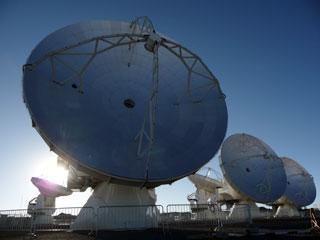
ALMA Telescope. Each of these radio telescopes has a dish spanning nearly 40 feet across. Photo: Tania Burchell, NRAO/AUI/NSF
CAMBRIDGE, MASSACHUSETTS (BNS): The world's most complex ground-based astronomy observatory, the Atacama Large Millimeter/submillimeter Array (ALMA), has officially opened for astronomers.
The ALMA is being built on top of the highest plateau (16,500 feet) in the Atacama Desert, in northern Chile. Around one third of ALMA's eventual 66 radio telescopes will make up the growing array.
Considering the limited number of hours allocated to this first phase of science, ALMA could only take about a hundred projects. "We were stunned when we received over nine hundred requests from all over the world," said Lewis Ball, ALMA Deputy Director and ALMA Chief of Staff at the National Radio Astronomy Observatory (NRAO).
"No other telescope on ground or in space has ever had this magnitude of over-demand." The successful projects were chosen based on their scientific value, their regional diversity, and also their relevance to ALMA's major science goals, he said.
The 'M' in ALMA stands for 'millimeter/submillimeter' waves, because ALMA views the Universe in these long wavelengths of light, much longer than the optical light we see with our eyes, said Alison Peck, an NRAO astronomer serving as ALMA Deputy Project Scientist during construction.
"With millimeter and submillimeter waves, we can watch planet formation, investigate astrochemistry, and detect the light that is finally reaching us from the Universe's earliest galaxies. ALMA's first projects will flex the telescope's capabilities in all of these fields and many, many more."
ALMA will continue its construction phase in the Chilean Andes, high on the remote Chajnantor Plain in the harsh Atacama Desert. By 2013, ALMA will be an up to 11-mile-wide array of 66 ultra-precision millimeter/submillimeter wave radio telescopes working together as one and built by ALMA's multinational partners in North America, East Asia, and Europe.
 Previous Article
Previous Article Next Article
Next Article













The Indian Air Force, in its flight trials evaluation report submitted before the Defence Ministry l..
view articleAn insight into the Medium Multi-Role Combat Aircraft competition...
view articleSky enthusiasts can now spot the International Space Station (ISS) commanded by Indian-American astr..
view article